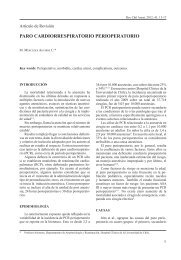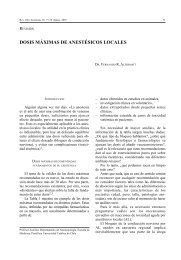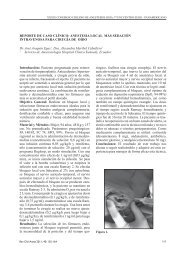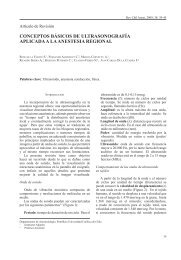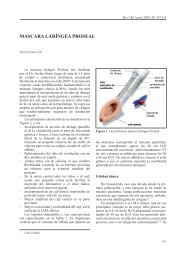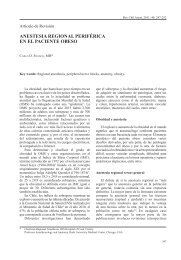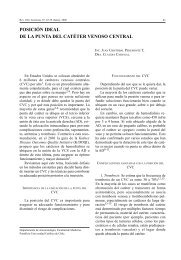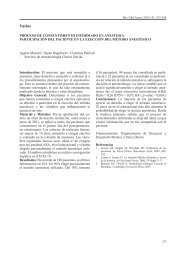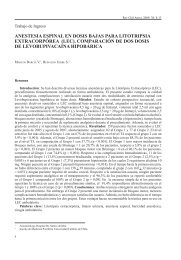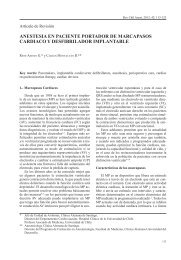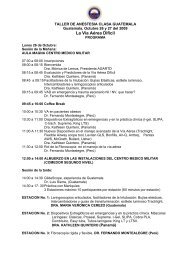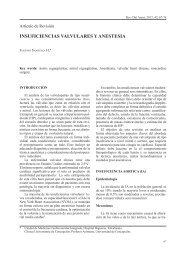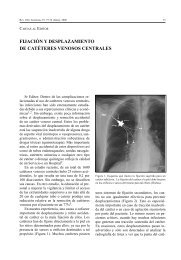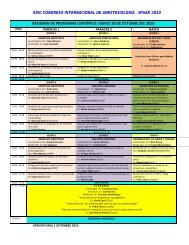rCP PEDIÁTrICA y nEonATAL: ConSIDErACIonES ESPECIALES y ...
rCP PEDIÁTrICA y nEonATAL: ConSIDErACIonES ESPECIALES y ...
rCP PEDIÁTrICA y nEonATAL: ConSIDErACIonES ESPECIALES y ...
Create successful ePaper yourself
Turn your PDF publications into a flip-book with our unique Google optimized e-Paper software.
Sandra Benavides O. et al.<br />
121. Repetto JE, Donohue P-CP, Baker<br />
SF, Kelly L, Nogee LM. Use of<br />
capnography in the delivery room<br />
for assessment of endotracheal tube<br />
placement. J Perinatol 2001; 21:<br />
284-287.<br />
122. Roberts WA, Maniscalco WM,<br />
Cohen AR, Litman RS, Chhibber<br />
A. The use of capnography<br />
for recognition of esophageal<br />
intubation in the neonatal intensive<br />
care unit. Pediatr Pulmonol 1995;<br />
19: 262-268.<br />
123. Aziz HF, Martin JB, Moore JJ.<br />
The pediatric disposable endtidal<br />
carbon dioxide detector role<br />
in endotracheal intubation in<br />
newborns. J Perinatol 1999; 19:<br />
110-113.<br />
124. Leone TA, Lange A, Rich W,<br />
Finer NN. Disposable colorimetric<br />
carbon dioxide detector use as an<br />
indicator of a patent airway during<br />
noninvasive mask ventilation.<br />
Pediatrics 2006; 118: 202-204.<br />
125. Berg RA, Hilwig RW, Kern KB,<br />
Babar I, Ewy GA. Simulated<br />
mouth-to-mouth ventilation and<br />
chest compressions (bystander<br />
cardiopulmonary resuscitation)<br />
improves outcome in a swine<br />
model of prehospital pediatric<br />
asphyxia cardiac arrest. Crit Care<br />
Med 1999; 27: 1893-1899.<br />
126. Berg RA, Hilwig RW, Kern<br />
KB, Ewy GA. “Bystander”<br />
chest compressions and assisted<br />
ventilation independently improve<br />
outcome from piglet asphyxia<br />
pulseless “cardiac arrest”.<br />
Circulation 2000; 101: 1743-1748.<br />
127. Babbs CF, Nadkarni V. Optimizing<br />
chest compression to rescue<br />
ventilation ratios during onerescuer<br />
CPR by professionals and<br />
lay persons: children are not just<br />
little adults. Resuscitation 2004; 61:<br />
173-181.<br />
128. Srikantan SK, Berg RA,<br />
Cox T, Tice L, Nadkarni<br />
VM. Effect of one-rescuer<br />
compression/ventilation ratios on<br />
cardiopulmonary resuscitation<br />
in infant, pediatric, and adult<br />
manikins. Pediatr Crit Care Med<br />
2005; 6: 293-297.<br />
129. Whyte SD, Sinha AK, Wyllie JP.<br />
Neonatal resuscitation-a practical<br />
assessment. Resuscitation 1999; 40:<br />
21-25.<br />
130. Greingor JL. Quality of cardiac<br />
massage with ratio compressionventilation<br />
5/1 and 15/2.<br />
Resuscitation 2002; 55: 263-267.<br />
131. Dorph E, Wik L, Steen PA.<br />
Effectiveness of ventilationcompression<br />
ratios 1:5 and 2:15 in<br />
simulated single rescuer paediatric<br />
resuscitation. Resuscitation 2002;<br />
54: 259-264.<br />
132. Haque IU, Udassi JP, Udassi S,<br />
Theriaque DW, Shuster JJ, Zaritsky<br />
AL. Chest compression quality<br />
and rescuer fatigue with increased<br />
compression to ventilation ratio<br />
during single rescuer pediatric<br />
CPR. Resuscitation 2008; 79: 82-<br />
89.<br />
133. Orlowski JP. Optimum position<br />
for external cardiac compression<br />
in infants and young children. Ann<br />
Emerg Med 1986; 15: 667-673.<br />
134. Phillips GW, Zideman DA.<br />
Relation of infant heart to sternum:<br />
its significance in cardiopulmonary<br />
resuscitation. Lancet 1986; 1: 1024-<br />
1025.<br />
135. Braga MS, Domínguez TE, Pollock<br />
AN, et al. Estimation of optimal<br />
CPR chest compression depth<br />
in children by using computer<br />
tomography. Pediatrics 2009; 124:<br />
e69-74.<br />
136. Houri PK, Frank LR, Menegazzi JJ,<br />
Taylor R. A randomized, controlled<br />
trial of two-thumb vs two-finger<br />
chest compression in a swine infant<br />
model of cardiac arrest. Prehosp<br />
Emerg Care 1997; 1: 65-67.<br />
137. David R. Closed chest cardiac<br />
massage in the newborn infant.<br />
Pediatrics 1988; 81: 552-554.<br />
138. Thaler MM, Stobie GH. An<br />
improved technique of external<br />
caridac compression in infants<br />
and young children. N Engl J Med<br />
1963; 269: 606-610.<br />
139. Perondi MB, Reis AG, Paiva<br />
EF, Nadkarni VM, Berg RA.<br />
A comparison of highdose and<br />
standard-dose epinephrine in<br />
children with cardiac arrest. N Engl<br />
J Med 2004; 350: 1722-1730.<br />
140. PattersonMD,Boenning DA, Klein<br />
BL, et al. The use of high-dose<br />
epinephrine for patients with<br />
out-of-hospital cardiopulmonary<br />
arrest refractory to prehospital<br />
interventions. Pediatr Emerg Care<br />
2005; 21: 227-237.<br />
141. Vandycke C, Martens P. High dose<br />
versus standard dose epinephrine<br />
in cardiac arrest-a meta-analysis.<br />
Resuscitation 2000; 45: 161-166.<br />
142. Jankov RP, Asztalos EV, Skidmore<br />
MB. Favourable neurological<br />
outcomes following delivery room<br />
cardiopulmonary resuscitation<br />
of infants < or = 750 g at birth. J<br />
Paediatr Child Health 2000; 36:<br />
19-22.<br />
143. O’Donnell AI, Gray PH,<br />
Rogers YM. Mortality and<br />
neurodevelopmental outcome for<br />
infants receiving adrenaline in<br />
neonatal resuscitation. J Paediatr<br />
Child Health 1998; 34: 551-556.<br />
144. Crespo SG, Schoffstall JM, Fuhs<br />
LR, Spivey WH. Comparison<br />
of two doses of endotracheal<br />
epinephrine in a cardiac arrest<br />
model. Ann Emerg Med 1991; 20:<br />
230-234.<br />
145. Jasani MS, Nadkarni VM,<br />
Finkelstein MS,Mandell GA,<br />
Salzman SK, Norman ME.<br />
Effects of different techniques<br />
of endotracheal epinephrine<br />
administration in pediatric<br />
porcine hypoxic-hypercarbic<br />
cardiopulmonary arrest. Crit Care<br />
Med 1994; 22: 1174-1180.<br />
146. Kirkman HN, Riley Jr HD.<br />
Posthemorrhagic anemia and shock<br />
in the newborn due to hemorrhage<br />
during delivery; report of 8 cases.<br />
Pediatrics 1959; 24: 92-96.<br />
147. Wyckoff M, Garcia D, Margraf L,<br />
Perlman J, Laptook A. Randomized<br />
trial of volume infusion during<br />
resuscitation of asphyxiated<br />
neonatal piglets. Pediatr Res 2007;<br />
61: 415-420.<br />
148. Mayock DE, Gleason CA.<br />
Cerebrovascular effects of rapid<br />
volume expansion in preterm fetal<br />
sheep. Pediatr Res 2004; 55: 395-<br />
399.<br />
149. Ellemunter H, Simma B, Trawoger<br />
R, Maurer H. Intraosseous lines<br />
in preterm and full term neonates.<br />
Arch Dis Child Fetal Neonatal Ed<br />
1999; 80: F74-75.<br />
150. Glaeser PW, Hellmich TR,<br />
Szewczuga D, Losek JD, Smith<br />
DS. Five-year experience in<br />
prehospital intraosseous infusions<br />
in children and adults. Ann Emerg<br />
Med 1993; 22: 1119-1124.<br />
151. Box D, Cochran D. Safe reduction<br />
in administration of naloxone to<br />
newborn infants: an observational<br />
study. Acta Paediatr 2006; 95:<br />
1083-1086.<br />
152. Gibbs J, Newson T, Williams J,<br />
Davidson DC. Naloxone hazard<br />
in infant of opioid abuser. Lancet<br />
1989; 2: 159-160.<br />
153. Cramer K, Wiebe N, Hartling L,<br />
Crumley E, Vohra S. Heat loss<br />
prevention: a systematic review of<br />
occlusive skin wrap for premature<br />
neonates. J Perinatol 2005; 25: 763-<br />
769.<br />
154. Vohra S, Roberts RS, Zhang B,<br />
Janes M, Schmidt B. Heat loss<br />
prevention (HeLP) in the delivery<br />
room: a randomized controlled<br />
trial of polyethylene occlusive skin<br />
wrapping in very preterm infants. J<br />
Pediatr 2004; 145: 750-753.<br />
78<br />
Rev Chil Anest 2012; 41: 57-79




